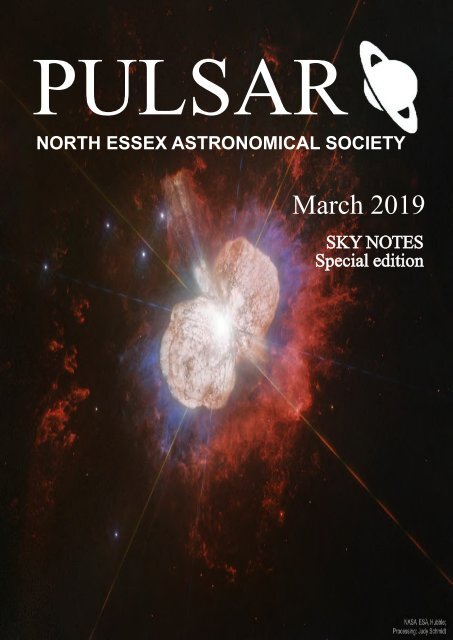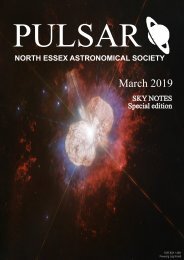Sky Notes March 19 turn
Create successful ePaper yourself
Turn your PDF publications into a flip-book with our unique Google optimized e-Paper software.
PULSAR<br />
NORTH ESSEX ASTRONOMICAL SOCIETY<br />
<strong>March</strong> 20<strong>19</strong><br />
SKY NOTES<br />
Special edition
Image credit: NASA
<strong>March</strong> 20<strong>19</strong><br />
The Spring Equinox arrives on <strong>March</strong> 20th and around this date daylight expands at its fastest<br />
for the year – increasing by about 4 minutes each day. The clocks go forward to British Summer<br />
Time on Sunday 31st <strong>March</strong> when at 1 am the clocks go to 2 am and we then stay on BST<br />
until late October. So on April 1st sunset is at 7.30 pm BST and twilight will last until 9.30<br />
pm BST.<br />
Full Moon this month is in the early hours of the 21st. Our nearest neighbour in space will<br />
then be in the constellation of Virgo and some 20 degrees lower in the sky when in the South<br />
compared to a mid-winter Full Moon.<br />
This month marks the 50th anniversary of the Apollo 9 mission. NASA was under pressure<br />
as the <strong>19</strong>60’s drew to a close to achieve the goal set by JFK in <strong>19</strong>62 of landing on the Moon<br />
before the end of the decade. It was a period of only months between Apollo 8 being the first<br />
crewed spacecraft to leave Earth orbit at the end of <strong>19</strong>68, to the successful landing on the Moon<br />
by Apollo 11 in July <strong>19</strong>69.<br />
But between these achievements NASA had to test the equipment and methods that would be<br />
needed for the landing. Apollo 9 was a “low key”, but vital Earth-orbiting mission that lasted<br />
10 days and was used to test the Apollo lunar module for the first time.<br />
Mars is still an evening object setting at about 11 pm by the end of the month. It is by then<br />
mag +1.4 and with a disk under 5 arcseconds in diameter. The young crescent Moon will be<br />
close by on the evening of <strong>March</strong> 11th. This early Spring period is an ideal time to see if<br />
Earthshine is visible on the part of the young Moon not lit by the Sun.<br />
Jupiter remains an early morning object and will be very close to the last quarter Moon on the<br />
morning of the 27th, best seen in the South at 5 am, or just before.<br />
Comet 2018 Y1 (Iwamoto) passed 0.3 AU from the Earth on February 12th and was an easy<br />
object in large binoculars. It fades through <strong>March</strong> but remains an evening object in the West<br />
– as ever the BAA Comet Section has details on all currently observable comets.<br />
Before the Moon waxes towards Full, late evenings during the second week of <strong>March</strong> will be<br />
a good time in dark skies to view galaxies. The Virgo cluster will be well placed at this time<br />
– located high in the “bowl” of Virgo and swarming around the giant elliptical galaxy M87.<br />
Everything about M87 is big. It is home to several trillion stars, a relativistic jet being powered
y the central super-massive black hole and a family of roughly 15,000 globular clusters –<br />
compared to the 157 globular clusters associated with the Milky Way.<br />
The Virgo Cluster is the closest and best-studied great cluster of galaxies, at a distance of<br />
approximately 50 to 70 million light years. It is the nucleus of the Local Supercluster of<br />
galaxies, in whose outskirts we in the Milky Way and the Local Group are situated – and<br />
gravitationally associated. 15 of the 109 Messier objects are Virgo Cluster galaxies.<br />
In the first week or so of <strong>March</strong> the full array of Winter constellations are still well placed in<br />
the evening, though not for much longer as we head into Spring. At 9 pm, Sirius is in the South<br />
and above it and a bit to the left is Procyon. Both stars are bright as we see them and, in<br />
astronomical terms, in “our neighbourhood”, Sirius being only 9 light years away and Procyon<br />
11 light years distant. To the right of Procyon the imposing outline of the constellation Orion<br />
has all of its primary stars much further away from us. Notably, Rigel, whilst it appears only<br />
slightly brighter than Procyon, is in fact over 700 light years away, shining with a luminosity<br />
around 80,000 times greater than our Sun. If Rigel were the same distance from us as Procyon,<br />
it would be as bright as a first quarter Moon and casting shadows at night.<br />
James Abbott<br />
Picture: M87 - credit The Hubble Heritage Team




